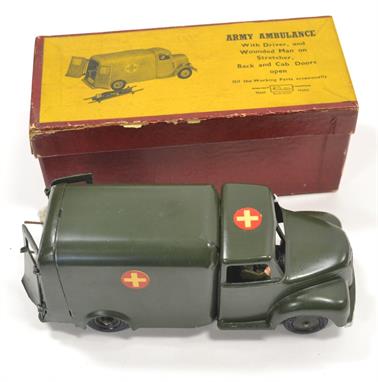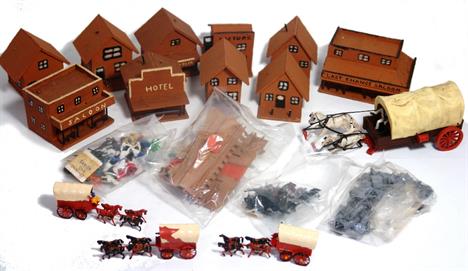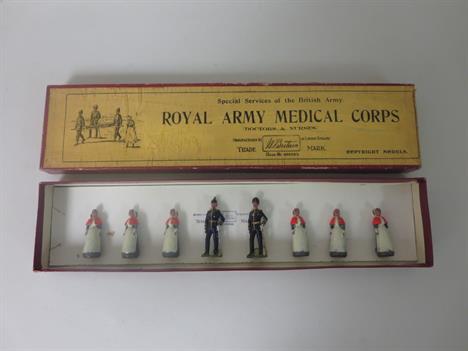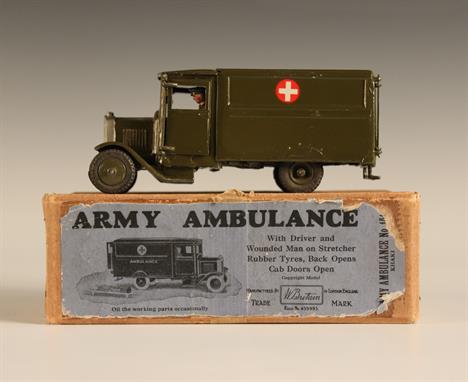Old Spec deactivated Colt pattern M119A1 U.S.A. Army .45 calibre semi-automatic pistol, barrel stamped - 'Remington Rand Inc Syracuse N.Y. U.S.A. and United States Property no. 826682, Deactivation Certificate 0045325 (February 1994), with U.S. Military leather holster, oil can, spare tin and turn screw (5) CONDITION REPORT Good overall condition old style de-ac so slide moves and can be cocked and dry fired, complete with magazine
We found 116692 price guide item(s) matching your search
There are 116692 lots that match your search criteria. Subscribe now to get instant access to the full price guide service.
Click here to subscribe- List
- Grid
-
116692 item(s)/page
A RARE GERMAN INFANTRY OFFICER`S DEGEN, CIRCA 1880, MOUNTED WITH AN EARLIER BLADE CARRIED BY AN 18TH CENTURY OFFICER IN THE SERVICE OF CARL THEODORE, PRINCE ELECTOR, COUNT PALATINE AND DUKE OF BAVARIA with slender two-stage blade, the upper portion decorated over its length on both sides with a serpent-like flattened medial ridge with bevelled wavy edges and cut with a filed chequered pattern, the lower portion blued, decorated on both sides with a series of filed indented designs including, on one face, the Electoral cipher "CT" together with a series of finely etched and gilt motifs, including a bust portrait of the Elector beneath his named scroll and the collar of the Bavarian Order of Saint George suspended from the Electoral Crown, and the same devices framing on the reverse side the arms both of the Elector Palatine and of Wittelsbach jointly suspending the Electoral cipher; with regulation gilt-brass hilt including up-turned double shell-guard, the pommel, the quillon and the knuckle-guard each decorated with leaf ornament cast in low relief, original wire-bound grip, and in its original scabbard 84 cm; 33 in blade The blade was presumably carried by a forebear who had served in the army of the Elector Carl Theodore, probably during the War of the Bavarian Succession (1778-9)
A 26-BORE WALLOON FLINTLOCK WENDER CARBINE BY GILLE DE SELIER, CIRCA 1705-10, RESTOCKED IN GERMANY IN 1799 with turn-over smooth-bored barrels released by backward pressure on the front of the trigger-guard, each signed on the long sighting flat, finely engraved and chiselled over the rear section with small leaf designs and a monster, with differing classical triumphant warrior figures chiselled in low relief upon vacant cartouches festooned with laurel, the breeches raised, flattened over the top and the sides, engraved with further leaf ornament and struck three times with the maker`s brass-lined stamp (Neue Støckel 8241), the plates fitted respectively over the faces of the breeches and the action each engraved with bands of acanthus leaves encircling their sides, the action tang engraved with leaf ornament and a Minerva bust , the plates carrying the pans each decorated with engraved beaded and acanthus borders, and the steels each chiselled with a flower in low relief, with signed bevelled lock with matching engraved borders and decorated in relief at the rear with a putto figure seated within a festooned scrollwork finial (the cock missing, one steel-spring broken), figured walnut butt profusely decorated with carved relief scrollwork patterns involving flowers and bouquets, the base of the cheek-piece signed by the German stockmaker "J.A. Körner 1799", the fore-end carved en suite and inset with three engraved iron scrollwork plaques opposite the ramrod-pipes and fitted with engraved iron cap, retaining the original iron butt-plate, side-plate, trigger-guard and ramrod-pipes, the butt-plate finely chiselled and engraved and involving a trophy of classical armour with captive figures, garlands and a mask all in low relief upon the upper tang, the side-plate pierced and chiselled with scrolls and involving a further trophy supported by putti, the trigger-guard decorated with a grotesque mask chiselled in low relief and with an engraved female bust, perhaps Flora, a pair of baluster ramrod-pipes, and iron-tipped wooden ramrod (one ramrod-pipe missing) 73 cm; 28¾ in barrels Gille de Sellier was a member of a dynastic family of gunmakers; he is recorded working in Liège circa 1680-1710, in 1693 de Selier supplied 30 carbines and 40 pairs of pistols to the Hanoverian army
A VERY RARE 15-BORE NORTH GERMAN WHEEL-LOCK SPORTING CARBINE WITH ENCLOSED RAINPROOF MECHANISM, SIGNED LUDIVIC HENRIC, NASSAU, DATED 1633 with octagonal sighted barrel lightly swamped at the muzzle, hexagonal bore cut with six grooves, signed in Latinised form "Lvdivicvs Henricvs Comes Nassovicvs", dated "1633", struck twice with the mark MS, a clover leaf beneath (Neue Støckel 4048) and struck with a further mark, the arms of the Counts of Nassau (Neue Støckel 5509, a lion), flat lock-plate engraved over its full surface, involving a pair of male and female figures in contemporary dress embracing within a field of scrolling flowers and seated upon a slab, the latter cut with the enigmatic inscription "O:L: Was Thvs Tv Aô 1633", fitted with internal wheel , the spindle entering from the left and concealed on that side by a pivot cap disguised as a large screw-head, fitted with conventional pan closed by a domed moulded rectangular cover also forming the pyrites-holder and pivoting forwards on an internal spring, the cover fitted with a threaded adjustable lifting-peg also forming an internal clamp for the pyrites held inside, and the lifting-peg baluster-shaped and pierced for a thong, fruitwood full stock carved with a scallop shell moulding in low relief at the base of the fore-end, inlaid over its length with a series of engraved dark horn plaques, including hares pursued by hounds along both sides of the fore-end, rosettes for the barrel-pins and the side-nails, a stylised circular peacock plaque seating the spindle-cover, further game animals including a fox pursued by a hound over the butt, and the cheek-piece decorated with another pair of amorous figures as falconers on a shared mount, fitted with sliding patch-box cover veneered in engraved horn plaques, horn butt-plate with iron finial, iron trigger-guard, iron ramrod-pipe, engraved horn fore-end cap, and bone-tipped wooden ramrod (the back-sight and small pieces of inlay missing) 64.8 cm; 25½ in barrel Wheel-lock firearms built with an enclosed rainproof mechanism are very rare and the present carbine is possibly the earliest dated example. The maker is apparently unrecorded and no German or Dutch derivatives of his name are found in the published gunmaking references either. The system was developed in about 1630 and appears to have remained in vogue at least until about 1653, although merely as a luxurious novelty to judge by the prestigious but very few surviving examples. The leading exponent of the system, and perhaps its inventor, was the celebrated French clockmaker Pierre Bergier of Grenoble. In 1635/6 Bergier, in collaboration with Chabriens de Montélimar, produced two pairs of two-shot superimposed-load pistols on a variation of this system involving coiled internal mainsprings; one of these was made for Louis XIII and is preserved in the Musée de l`Armée, Paris (Inv. M 1659), the other pair was made for the Dauphin, later Louis XIV, and formerly in the collection of William Goodwin Renwick. There are two further extant pairs of pistols with wheel-locks built on this system, one by La Fonteyne a Mourgues, circa 1645 (in the Army Museum, Prague), the other by a member of the Bavarian Gsell family of Arzberg, made for Duke Julius Heinrich of Saxony and dated 1653 (Tøjhus Museum, Copenhagen). The lock mechanism of the present carbine is built on a conventional branched mainspring; the construction principles of this lock and of its spanning arrangement compare most closely with those of two French wheel-lock fowling-pieces, circa 1640, now in the Musée de l`Armée (Inv. M 405 & M 404); the first is number 103 in the 1729 inventory of the Royal Cabinet d`Armes. See Reverseau 2004, pp.100-107. A pair of wheel-lock carbines in the armoury of Carl Gustav Wrangel in Skokloster castle are struck with the barrelmaker`s identical mark, together also with the mark in the form of the arms of the Counts of Nassau. The pair, dated 1627, is attributed to an unspecified Dutch origin on the basis of inclusion of the arms of Nassau, with which the stocks are inlaid also, and of its Dutch historical provenance: see Meyerson & Langström 1984, p. 151, Cat. No. 66-7. For a survey of 17th century wheel-lock firearms with enclosed mechanisms see Hoff 1969, pp.116-120
AN 18 BORE FRENCH D.B. PERCUSSION SPORTING GUN BY BRUNÉEL A LYON, CIRCA 1830 with twist sighted barrels, engraved breech, engraved tang incorporating the back-sight, flush-fitting locks signed in ovals enclosed by fronds, figured walnut half-stock, chequered grip and fore-end, the former carved with a green man mask in the round, raised cheek-piece carved with a griffon, steel mounts including trigger-guard with finial of shaped outline and hinged butt-cap concealing cavities for balls, percussion caps and a bayonet, white metal barrel bolt escutcheons and vacant escutcheon, and associated ramrod 86.5 cm; 34 1/8 in barrels Brunel is recorded in Lyon circa 1825-50. He invented a percussion gun that was tested by the French army in 1827 and was manufactured in the following year at the Maubeuge arsenal.
AN INDIAN PARRYING SHIELD (MADU), 19TH CENTURY of characteristic form, the first with a pair of long horns with iron basal caps, joined by a pair of bolts retaining a small iron shield with reinforced brass border, fitted at its centre with a spike and a brass washer from a British Army bit boss, marked Infantry Mounted Officer and the horn terminals each with reinforced iron spike; the second similar, with shorter horns fitted with reinforced iron spikes the first: 84.5 cm; 33 1/4 in (2)
A RARE SENIOR OFFICER`S DE-LUXE QUALITY DRESS SABRE WITH HILT AND SCABBARD MOUNTS OF PARCEL-GILT SILVER, BADEN OR WÜRTTEMBERG, THIRD QUARTER OF THE 19TH CENTURY with curved single-edged flat blade etched over its length in imitation of a damascus pattern, etched with laurel branches and gilt trophies-of-war on both sides, enclosing the figures of Mars and Venus etched and gilt on respective sides, and etched and gilt with a striped pattern along the back-edge, silver stirrup-hilt cast in relief, formed of a knuckle-guard with two oval bars branched diagonally across the outer face, with the quillon terminal formed as a dog`s head cast in the round, a pair of langets, the outer langet decorated with a silver-gilt lion mask in high relief, back-piece also of silver-gilt and rising to an eagle`s head pommel, and ebony grip carved with a scale pattern, in its original leather-covered wooden scabbard with parcel-gilt silver mounts cast in relief with subjects en suite with the blade, the locket involving the figure of Victory, and the middle-band applied with a fluted plaque carrying the cipher WR crowned, silver maker`s stamp of Sick of Stuttgart; complete with its portepee incorporating the black, white and red Federal colours 74.5 cm; 29¼ in blade The cypher on the middle-band of the scabbard is possibly that of the 2. Badisches Grenadier Regiment, Kaiser Wilhelm I. The regiment was established in 1852 and became a part of the Baden contingent of the Prussian army in 1871, under the designation Infanterie Regiment Nr. 110
A RARE SEVEN YEARS` WAR FRENCH REGULATION HUSSARS` SABRE, À LA HONGROISE, OF THE REGIMENT DE BERCHINŸ, CIRCA 1752-67 with long slender curved blade double-edged towards the point, cut with a pair of narrow fullers bordering the greater central portion of the back-edge, etched with the royal arms of France below the figure of a hussar on both sides towards the base, with cartouches enclosing the inscriptions "Regiment de Berchinÿ" on one face and "Vive le Roÿ" on the other, and the back-edge etched with the signature of the fourbisseur "Berger Marchand Fourbisseur a Strasborg"(sic), brass hilt of flat bars with bevelled edges, including rounded double langets on both sides, cap pommel with a brass drop-shaped washer under the tang button, original grip bound with leather over cords, with a single brass-capped rivet on either side, fitted with back-piece, and in un-restored condition throughout 92.5 cm; 36 3/8 in blade This sabre conforms to the pattern set out in the French regulations for Hussars on 15th May 1752. The Berchiny Hussar regiment was raised in 1719 by a Hungarian Lieutenant, Count Ladislas Ignace de Berchenÿ (1689-1778). Three squadrons of the regiment, comprising 65 officers and 470 men, fought in the German campaign of 1743. During the Seven Years` War four squadrons of the regiment formed a part of the Light Troops of the Right Reserve of the French army of the Lower Rhine, June 1758-May 1760, and fought with distinction. See Pétard 1999, Vol. I, no.57a, pp. 76-7. For a variant de Berchinÿ sabre, its blade etched in a near-identical manner, see Blondieau 2002, p.91.
Egyptian Lapis Lazuli Horemheb Scarab Gold Ring18th Dynasty, 1550-1292 BC. A lapis lazuli scarab with inscription to the underside for Horemheb, set in a 19th century gold swivel ring. 6.57 grams, 28mm overall, 19.03mm internal diameter (approximate size British R 1/2, USA 9, Europe 19.69, Japan 19) (1"). Ex Hubbard collection, London, UK; acquired on the UK art market from 1990. Horemheb, (meaning Horus is in Jubilation) was the last pharaoh of the 18th Dynasty of Egypt. Before he became pharaoh, Horemheb was the commander in chief of the army under the reigns of Tutankamun and Ay. After his accession to the throne, he reformed the state and it was under his reign that official action against the preceding Amarna rulers began Very fine condition.
Roman Iron Spatha SwordLate 2nd-4th century AD. A broad (4.5cm at shoulder) parallel-sided spatha with convergent tip, lentoid in section with one square and one slightly rounded shoulder; rectangular-section tang at the shoulder developing to square-section at the upper end, hammered over a domed bronze pommel-cap. Cf. Nørgård Jørgensen, A. & Andersen, H.C.H. Ejsbøl Mose. Die Kriegsbeuteropfering in Moor von Ejsbøl aus dem späten 1.Jh.v.Chr. bis zum frühen 5.Jh.n.Chr., Højbjerg, 2014, figs.23, 24; James, S. Excavations at Dura Europos 1928-1937. VII The Arms, Armour and Other Military Equipment, London, 2004, fig.85 (item 513); Bishop, M.C. & Coulston, J.C.N. Roman Military Equipment From the Punic Wars to the Fall of Rome, London, 1993, fig. 86(7). 692 grams, 74cm (29"). Ex Northern English collection; found near Penrith, Cumbria, UK, 2010. The standard length for a spatha is between 75 and 100cm, the longer ones generally round-tipped and used by cavalry. The spatha came to replace the short, stabbing sword (often called a gladius) for the infantry from the 3rd century AD. Swords of this type are found often on the Rhine frontier and in northern Britain, as well as in the Danish bog-offerings such as Nydam and Ejsbøl. They were probably used by Germanic recruits in the late Roman army. The slight asymmetry of the shoulders is a feature on a few swords of the type, e.g. the Straubing sword, and was covered in use by the organic (wood or bone?) lower guard. The blade does not feature a fuller, neither is it lozengiform in section despite a slight thickening or `midrib` in the upper quarter. Fine condition.
A Timpo covered wagon, a quantity of scratch built wild west buildings, a quantity of Union and Confederate army soldier figures by Airfix, cowboys and Indians by the same manufacturer and also ten Airfix wagon trains with figures. CONDITION REPORT The front wheels are missing from the covered wagon.
The Army Long Service and Good Conduct Medal, Victorian issue with impressed naming to 17302 COY SEJT MAJOR R. STAPLETON. R.E., The Khedive's Egypt Star 1882, The National Fire Brigade's Association Bronze Medal for Long Service with two bars detailed Five Years, Ten Years and another medal, possibly American.
Five Second World War medals, comprising; The 1939-45 Star, The Africa Star, with bar 1ST ARMY, The Italy Star, The Defence Medal and The War Medal, with an Army Council forwarding slip and box, a silver gilt, enameled and diamond set Masonic Jewel, detailed Elizabeth Boswell-Reid Lodge No 7, cased, two Parker fountain pens and two Parker propelling pencils.
A First World War Princess Mary gift tin, containing various cigarette cards by Players and others, a paper knife in the form of a Third Reich army dagger with cast hilt, a Princess Christian`s Army Nursing Service Reserve badge, No. 483, further badges, an 1892 crown, a silver coloured metal ring cast with skull, inert cartridges, empty tins, etc.
A General Service Medal, George VI issue, with bar `Palestine` to `2319007. Dvr. L.W. Van. R.Signals.`, and a 1939-45 Star, Italy Star, 1939-45 Defence Medal, War Medal and Army Long Service and Good Conduct Medal, Elizabeth II issue, the suspension bar detailed `Regular Army`, to `22515729 Sigmn. L.W.G. Vann. R.Sigs.`, mounted on a bar as worn.
A 1914-18 British War Medal and 1914-19 Victory Medal to `2.Lieut. E E. Watson.`, mounted on a bar as worn, with the corresponding dress miniature medals, and a 1939-45 Defence Medal with two ribbons and packet, with the accompanying Army Council forwarding slip confirming one award and with the OHMS box of postage, addressed to `Mr E.E. Watson 38 Cleveland Road Ealing W13`.
A Crimea Medal with four bars, `Alma`, `Balaclava`, `Inkermann` and `Sebastopol` (the Balaclava bar a jeweller`s copy), re-named in engraved sloping capitals `1433. Sergt. W.D. Colson. 13th Light Dragoons.` (the suspension repaired), a Turkish Crimea Medal with engraved naming in sloping capitals `1433. Sergt. W.D. Colson. 13th Light Dragoons`, detailed `La Crimea 1855`, and an Army Long Service and Good Conduct Medal, Victorian issue, re-named in engraved sloping capitals `1433. Sqd. QM. Sergt. W.D. Colson. 13th Hussars`.
A group of six miniature dress medals, comprising British Empire Medal, civil issue, 1914-15 Star, 1914-18 British War Medal, 1914-19 Victory Medal, India General Service Medal, George V issue, with bar `Afghanistan N.W.F. 1919`, and Army Long Service and Good Conduct Medal, George V issue, displayed in a frame.
A small collection of militaria, including nine cap badges, including two East Surrey, shoulder titles, including one TASC E Lancashire, collar badges, further badges, including a blue enamelled badge designed as an aeroplane, detailed `National League of Airmen 1935`, and a quantity of mostly British Army buttons and officers` pips, together with a base metal cased wrist compass and two gentlemen`s wristwatches, comprising Lanta and Waterproof Incabloc.
The Army Long Service and Good Conduct Medal, Victorian issue with impressed naming to 17302 COY SEJT MAJOR R. STAPLETON. R.E., The Khedive's Egypt Star 1882, The National Fire Brigade's Association Bronze Medal for Long Service with two bars detailed Five Years, Ten Years and another medal, possibly American.
Five Second World War medals, comprising; The 1939-45 Star, The Africa Star, with bar 1ST ARMY, The Italy Star, The Defence Medal and The War Medal, with an Army Council forwarding slip and box, a silver gilt, enameled and diamond set Masonic Jewel, detailed Elizabeth Boswell-Reid Lodge No 7, cased, two Parker fountain pens and two Parker propelling pencils.
A collection of Dinky Toys army vehicles and field guns, comprising a No. 621 3-ton army wagon, two No. 623 army covered wagons (one with driver, one without), a No. 626 military ambulance, a No. 641 1-ton cargo truck, a No. 643 water tanker, two No. 675 Scout cars (one with driver, one without), a No. 674 Austin Champ, a No. 676 armoured personnel carrier, a No. 677 armoured command vehicle, a No. 686 25-pounder field gun, a No. 688 field artillery tractor, two No. 692 5.5 medium guns and a No. 693 7.2 Howitzer, all boxed (some boxes creased, scuffed and stained), together with an incomplete set of three No. 603 army personnel-private seated figures (9 missing), boxed (box torn and graffitied), a No. 670 armoured car, a Jeep and a limber.
-
116692 item(s)/page


















































